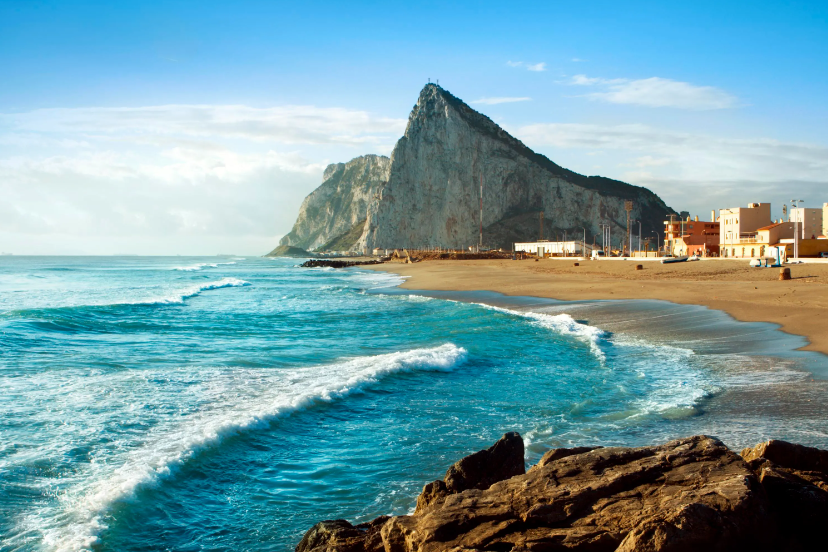
THE Strait of Gibraltar It's one of the most fascinating places in the world, where the Atlantic Ocean and the Mediterranean Sea meet, creating one of the most diverse and biodiverse regions on the planet. The strait is formed by a narrow channel that separates Europe and Africa, creating a natural gateway connecting two continents and two different cultures.
Explore the Strait of Gibraltar It's a unique adventure, where you can admire its majestic landscape and learn about its history and ecology. Throughout this article, we'll delve into the strait's geography, flora, fauna, historical significance, recreational activities, environmental challenges, and scientific research, so you can better understand its role as a natural wonder.
Main Conclusions:
- THE Strait of Gibraltar is a narrow channel that separates Europe and Africa.
- It's a wonder natural rich in biodiversity and history.
- There are a variety of recreational activities available in the area, including boating and diving.
- The strait faces environmental challenges such as marine pollution and biodiversity conservation.
- Scientific research is being carried out to better understand the ecology and challenges of the strait.
Location and Geography of the Strait of Gibraltar
The Strait of Gibraltar is a strip of water separating Europe from Africa, connecting the Mediterranean Sea to the Atlantic Ocean. Approximately 14 kilometers long, its depth varies between 300 and 900 meters, and it is possible to see both continents simultaneously from some points near the coast.
Geographically, the Strait of Gibraltar is known for its strategic location, serving as an important sea route since ancient times for trade and travel between the Mediterranean and the Atlantic. Furthermore, the region is characterized by strong and variable ocean currents, which play a significant role in the distribution of heat and salinity in the water, as well as the migration of marine animals.
| Feature | Details |
|---|---|
| Location | Between Europe and Africa, connecting the Mediterranean to the Atlantic |
| Extension | Approximately 14 kilometers |
| Depth | It varies between 300 and 900 meters |
| Ocean currents | Strong and variable, influencing the distribution of heat, salinity and migration of marine animals |
The Strait of Gibraltar region is one of the most biodiverse areas in the Mediterranean, with a wide variety of plant and animal species, including dolphins, whales, sea turtles and migratory birds.
In short, the location and the geography of the Strait of Gibraltar are fundamental factors in the history, trade and biodiversity of the region, making it a natural wonder unmissable for those who wish to explore its beauty.

Flora and Fauna of the Strait of Gibraltar
The Strait of Gibraltar is an important marine ecosystem home to a diverse range of plant and animal species. The region is rich in biodiversity and is considered one of the most important areas for bird migration in Europe and Africa.
The waters of the Strait of Gibraltar are a transition zone between the Atlantic and the Mediterranean, and boast a blend of fauna and flora from both regions. Animal species include dolphins, whales, sea turtles, sharks, and various fish species, such as tuna and sea bream. Among the plant species, we find seaweed and endemic species that lend beauty and uniqueness to the region.
| Plant Species | Animal Species |
|---|---|
| Seaweed | Dolphins |
| Agave Marina | Whales |
| Juniper | Sea Turtles |
| Juniper | Sharks |
| Laurel | Tuna |
Conserving the Strait of Gibraltar ecosystem is crucial for maintaining marine life in the region. Human activities, such as overfishing and pollution, endanger these species and harm the entire local ecosystem.
In short, the Strait of Gibraltar is a true treasure trove of biodiversity. The flora and fauna present in the region are of paramount importance to marine life and the broader ecosystem, making the need to preserve and protect this natural heritage even more urgent.
Historical Importance of the Strait of Gibraltar
The Strait of Gibraltar has a historical significance dating back millennia. Various ancient peoples, such as the Phoenicians, Romans, and Carthaginians, used this strategic waterway to strengthen their trade routes and expand their empires. As a key meeting point between Europe and Africa, the Strait of Gibraltar has been the scene of epic battles and unique cultural exchanges throughout history.
In addition to cultural influences, the region was also the scene of important historical events, such as the Moorish invasions of the Iberian Peninsula and the entry of the Moors into Gibraltar in 711 AD. The region was disputed over the centuries by various kingdoms and empires, including the Visigoths, Romans and Moors.
The Battle of Trafalgar
One of the most significant events to occur in the Strait of Gibraltar was the Battle of Trafalgar in 1805, during the Napoleonic Wars. The battle involved the British fleet led by Admiral Nelson and the Franco-Spanish fleet led by Admiral Villeneuve. The British victory in the battle helped secure British naval dominance throughout the 19th century.
The Gibraltar Crisis
In the 20th century, the Gibraltar region was the scene of a major diplomatic dispute between the United Kingdom and Spain, known as the Gibraltar Crisis. The dispute involved sovereignty over the area and the construction of a British naval base. The issue was resolved in 1984, when the United Kingdom and Spain signed the Madrid Agreement, which determined the gradual return of control of Gibraltar to Spain.
Construction of the Gibraltar Channel
In 2002, the concept of building a canal to connect the Mediterranean Sea and the Atlantic Ocean resurfaced in discussions about the region. The proposed canal, dubbed the "European Panama Canal," would provide a shorter route for ships than the Strait of Gibraltar. However, the idea is still undergoing environmental, economic, and technical evaluations.
Important Historical Events in the Strait of Gibraltar
| Events | Date | Description |
|---|---|---|
| Phoenician Presence in the Strait of Gibraltar | Around 1100 BC | The Phoenicians established important trade routes in the Mediterranean and used the Strait of Gibraltar to strengthen their presence in the southern Iberian Peninsula. |
| Battle of Trafalgar | 1805 | The British victory at the Battle of Trafalgar during the Napoleonic Wars helped secure British naval dominance in the 19th century. |
| Gibraltar Crisis | 1969-1984 | The diplomatic dispute between the United Kingdom and Spain over the sovereignty of Gibraltar and a British naval base was resolved in 1984 with the signing of the Madrid Agreement. |
As we can see, the Strait of Gibraltar has an important and interesting history that has shaped the region over the centuries. This rich and fascinating history is one of the many reasons why the Strait of Gibraltar is a natural wonder worthy of exploration.

Recreational Activities in the Strait of Gibraltar
The Strait of Gibraltar is a popular tourist destination offering a variety of recreational activities for visitors of all ages. If you enjoy adventure and nature, this is the perfect place to explore.
Boat Tours
One of the best ways to enjoy the Strait of Gibraltar is by boat. There are several options to choose from, from sightseeing tours on large cruise ships to private tours on smaller boats for a more intimate experience. During the tour, you'll be able to admire the stunning landscapes of the strait and observe the rich diversity of marine life.
Dive
Another popular activity in the Strait of Gibraltar is diving. With crystal-clear waters and rich marine flora and fauna, it's the ideal place to go diving. Several companies offer diving courses, from beginners to the most advanced. experienced people who want to explore the wreckage of shipwrecks.
Marine Life Observation
If you'd rather stay safe, a boat tour to observe marine life is a great option. Many companies offer guided tours so you can see dolphins, whales, and other marine species in their natural habitat.
Beaches
For those who prefer to relax on the beach, the Strait of Gibraltar boasts some of the most beautiful beaches in the world, with clear waters and pleasant temperatures. The most famous beaches are Playa de Bolonia (Spain) and Playa de Tarifa (Spain), but there are several other beaches in the region worth visiting.
Trails
For hiking and trail lovers, the Strait of Gibraltar has much to offer. There are several trails in the region, with varying levels of difficulty, allowing you to explore the natural beauty of the region, from forests to mountains with panoramic views of the strait.
As you can see, there are countless recreational activities to discover in the Strait of Gibraltar. Choose your favorite activities and make the most of your experience!

Environmental Challenges in the Strait of Gibraltar
The Strait of Gibraltar currently faces several environmental challenges that threaten the region's biodiversity and the quality of life of local communities. One of the main problems is marine pollution, caused by improper waste disposal and heavy shipping traffic, especially those transporting oil and other chemicals.
Furthermore, overfishing and habitat degradation have contributed to the decline in populations of several species, such as tuna, dolphins, and sea turtles. These animals are important not only to the local ecosystem but also to the region's economy, as fishing and tourism are important activities in the Strait of Gibraltar area.
Biodiversity Conservation
To address these challenges, it is essential to adopt effective biodiversity conservation and environmental protection measures. This involves not only cleanup and inspection activities, but also encouraging sustainable fishing, creating marine protected areas, and promoting responsible tourism.
The importance of scientific research
It's also important to invest in scientific research to better understand marine ecosystems and the impacts of human activities in the Strait of Gibraltar region. This will enable the development of more effective conservation and natural resource management strategies.
| Environmental Challenges | Conservation Measures |
|---|---|
| Marine pollution | Awareness and inspection campaigns, encouraging recycling, and proper waste treatment. |
| Decrease in species populations | Sustainable fishing, creation of marine protected areas, biodiversity monitoring. |
| Tourism | Promotion of responsible tourism, encouragement of sustainable economic activities. |
In short, the environmental challenges in the Strait of Gibraltar are significant, but there is hope in the implementation of effective conservation and environmental protection measures. With the collaboration of governments, businesses, and civil society, it is possible to ensure that this wonder natural continue to enchant and sustain future generations.

Scientific Research in the Strait of Gibraltar
The Strait of Gibraltar is a region of great scientific interest. Its unique geographic location and rich biodiversity offer endless opportunities for innovative studies in a wide variety of fields.
Researchers from various fields are dedicated to better understanding the Strait of Gibraltar ecosystem and its associated phenomena, from ocean currents to species migration. The region is a unique natural laboratory for studies on the interaction between climate, ocean, and biology, with implications ranging from understanding climate change patterns to the adaptation of organisms to water flows of varying temperatures and salinities.
Some of the main research topics in the Strait of Gibraltar include:
| Research area | Study topics |
|---|---|
| Oceanography | Ocean currents, nutrient transport, climate variations, impacts of human activity on water quality |
| Ecology | Species migration, population dynamics, species interactions, response to environmental stimuli |
| Geology | Formation of the Strait, movement of tectonic plates, impacts of human activities on geodiversity |
The results of this research are crucial for developing strategies for the conservation, management, and sustainable exploitation of the Strait of Gibraltar's natural resources. Furthermore, scientific efforts in the region help expand our knowledge of the ocean and its importance to life on Earth.
In short, the scientific research in the Strait of Gibraltar are crucial to the preservation of one of the most incredible natural wonders on the planet.

Conclusion
In this section, we recap the most important points about the Strait of Gibraltar, a natural wonder that has a geographical location strategic location and a rich and fascinating biodiversity. We also discussed the region's historical importance, its recreational activities, and the environmental challenges it faces.
However, despite these challenges, it's important to remember the unique beauty of the Strait of Gibraltar and the crucial role it plays in connecting two important bodies of water. The region offers many exciting opportunities to explore and learn, whether through recreational activities or scientific research. Ultimately, the Strait of Gibraltar is a natural wonder to be appreciated and preserved for future generations.
FAQ
What is the Strait of Gibraltar?
The Strait of Gibraltar is a waterway located between the southern tip of the Iberian Peninsula and the north coast of Africa. It connects the Mediterranean Sea to the Atlantic Ocean.
What is the geographical importance of the Strait of Gibraltar?
The Strait of Gibraltar plays a crucial role as a strategic sea route. It serves as a transit point for commercial ships and vessels, connecting the Mediterranean Sea to the Atlantic Ocean.
What are the main species of flora and fauna found in the Strait of Gibraltar?
The Strait of Gibraltar is home to a rich diversity of flora and fauna. Among the species found in the region are dolphins, whales, sea turtles, migratory birds, and a variety of fish and marine plants.
What is the historical importance of the Strait of Gibraltar?
The Strait of Gibraltar has played a significant role in history, serving as a bridge between Europe and Africa, and has been the scene of important events such as naval battles and mass migrations.
What recreational activities are available in the Strait of Gibraltar?
Visitors to the Strait of Gibraltar can enjoy a variety of recreational activities, including boat trips to observe marine life, snorkeling and scuba diving, sport fishing, and even whale and dolphin watching.
What are the main environmental challenges faced in the Strait of Gibraltar?
The Strait of Gibraltar faces environmental challenges such as marine pollution, overfishing, and biodiversity conservation. These issues require conservation and awareness-raising actions to protect the region's ecosystem.
What scientific research is carried out in the Strait of Gibraltar?
Scientific research is carried out in the Strait of Gibraltar, exploring a variety of areas, including studies on ocean currents, marine species migration, the impacts of climate change, and water quality assessment.
Why is the Strait of Gibraltar considered a natural wonder?
The Strait of Gibraltar is considered a natural wonder for its strategic location, scenic beauty, biodiversity, and historical significance. Its uniqueness attracts tourists and scientists from around the world.
Lucas Wanderlust has a tireless spirit of adventure, always seeking new travel experiences. Fascinated by the world and the possibility of exploring unknown destinations, he fell in love with the sense of freedom and self-discovery that traveling alone provides. With a backpack on his back and a heart open to the unknown, Lucas embarks on exciting journeys, where each destination becomes a unique chapter in his life story. He gives himself body and soul to the magic of solo travel, inspiring others to follow in his footsteps and discover themselves through adventure.







